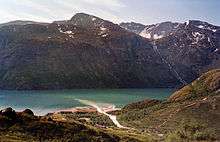Rock flour
Rock flour, or glacial flour, consists of fine-grained, silt-sized particles of rock, generated by mechanical grinding of bedrock by glacial erosion or by artificial grinding to a similar size. Because the material is very small, it becomes suspended in meltwater making the water appear cloudy, which is sometimes known as glacial milk.[1][2]

When the sediments enter a river, they turn the river's colour grey, light brown, iridescent blue-green, or milky white. If the river flows into a glacial lake, the lake may appear turquoise in colour as a result. When flows of the flour are extensive, a distinct layer of a different colour flows into the lake and begins to dissipate and settle as the flow extends from the increase in water flow from the glacier during snow melts and heavy rain periods. Examples of this phenomenon may be seen at Lake Pukaki and Lake Tekapo in New Zealand, Lake Louise, Moraine Lake, Emerald Lake, and Peyto Lake in Canada, Gjende lake in Norway, and several lakes (among others, Nordenskjöld and Pehoé) in Chile's Torres del Paine National Park.
Formation

Typically, natural rock flour is formed during glacial migration, where the glacier grinds against the sides and bottom of the rock beneath it, but also is produced by freeze-and-thaw action, where the act of water freezing and expanding in cracks helps break up rock formations. Multiple cycles create a greater amount.
Although clay-sized, the flour particles are not clay minerals but typically ground up quartz and feldspar. Rock flour is carried out from the system via meltwater streams, where the particles travel in suspension. Rock flour particles may travel great distances either suspended in water or carried by the wind, in the latter case forming deposits called loess.
Agricultural use
Thomas J. Goreau et al who wrote the book Geotherapy believe that mafic/ultra-mafic rock flour has a powerful effect in restoring trace minerals to soils, which increases the health and vigour of the Microorganism, Plantae, Animalia pathway and also sequesters carbon. An early experimenter was the German miller, Julius Hensel, author of Bread from Stones, who reported successful results with steinmehl (stonemeal) in the 1890s. His ideas were not taken up due to technical limitations and, according to proponents of his method, because of opposition from the champions of conventional fertilisers.
John D. Hamaker argued that widespread remineralization of soils with rock dust will be necessary to reverse soil depletion by current agriculture and forestry practice.
While this originally was an alternative concept, increasing mainstream research has been devoted to soil amendment and other benefits of rock flour application: for instance, a pilot project on the use of glacial rock, granite and basaltic fines by the U.S. Department of Agriculture exists at the Henry A. Wallace Beltsville Agricultural Research Center. The SEER Centre in Scotland is a leading source of information on the use of rock dusts and mineral fines. The Soil Remineralization Forum was established with sponsorship from the Scottish Environment Protection Agency and has commissioned a portfolio of research into the benefits of using mineral fines. The Forum provides an interface among research, environmentalists, and industry.
See also
References
- "Glossary of Terms: G: Glacial Milk" PhysicalGeography.net
- Gornitz, Vivien (editor) (2007) "Glacial Geomorphology" pp. 361-374 Encyclopedia of paleoclimatology and ancient environments Springer Netherland, Berlin, page 365, ISBN 978-1-4020-4551-6
External links
- Remineralize the Earth - "non-profit organization incorporated to disseminate ideas and practice about soil remineralization".
- Julius Hensel by John Mann
- The USGS Glossary of Glacial Terminology
